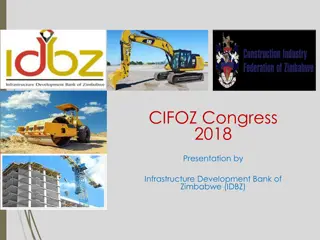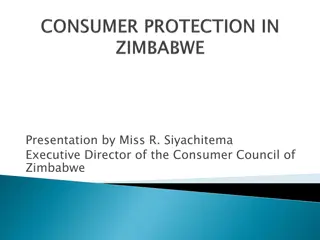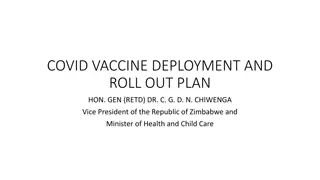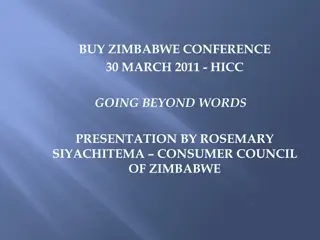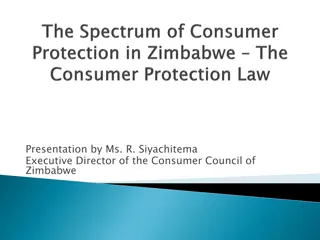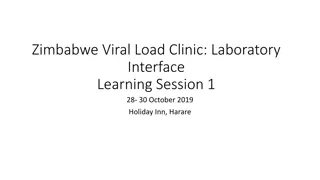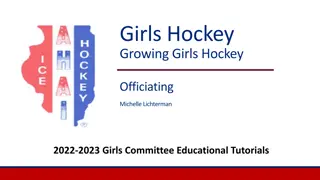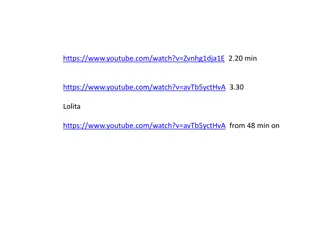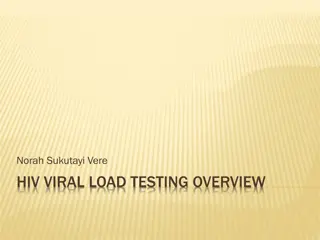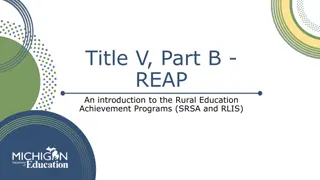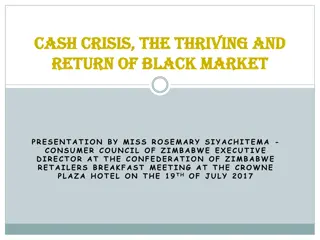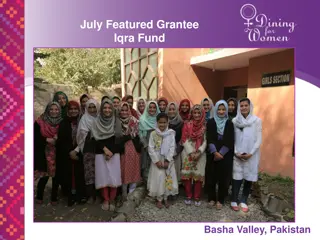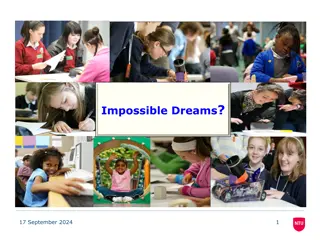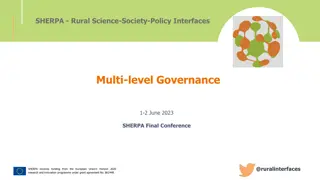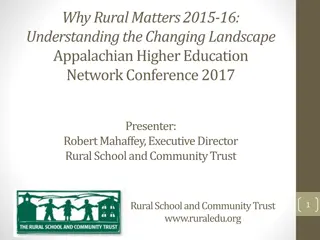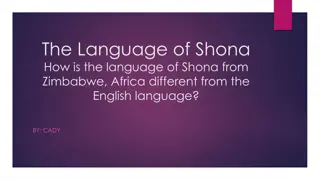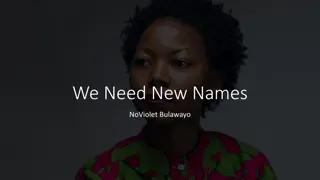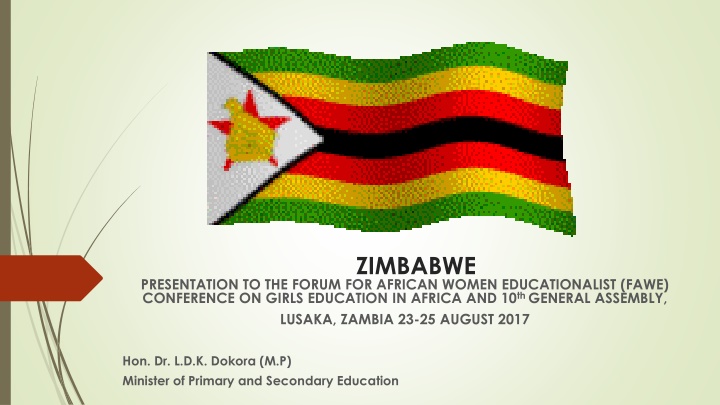
Zimbabwe's Efforts to Advance Girls' Education in Africa
"Explore Zimbabwe's journey in addressing barriers to girls' education, from historical disparities to current initiatives. Learn about policies, programs, and challenges in promoting gender equality in education."
Download Presentation

Please find below an Image/Link to download the presentation.
The content on the website is provided AS IS for your information and personal use only. It may not be sold, licensed, or shared on other websites without obtaining consent from the author. If you encounter any issues during the download, it is possible that the publisher has removed the file from their server.
You are allowed to download the files provided on this website for personal or commercial use, subject to the condition that they are used lawfully. All files are the property of their respective owners.
The content on the website is provided AS IS for your information and personal use only. It may not be sold, licensed, or shared on other websites without obtaining consent from the author.
E N D
Presentation Transcript
ZIMBABWE PRESENTATION TO THE FORUM FOR AFRICAN WOMEN EDUCATIONALIST (FAWE) CONFERENCE ON GIRLS EDUCATION IN AFRICA AND 10th GENERAL ASSEMBLY, LUSAKA, ZAMBIA 23-25 AUGUST 2017 Hon. Dr. L.D.K. Dokora (M.P) Minister of Primary and Secondary Education
Summary 2 Background to provision of education Barriers to Education for girls and young women Legal provisions for addressing gender disparities Some policies and programmes to promoting Quality Education Government expenditure on Education Measures to address Gender Disparities in education Basic education Gender Parity Index Current and ongoing initiatives to promote quality education Conclusion Hon. Dr. L.D.K. Dokora (M.P.)- Zimbabwe 4/21/2025
Background 3 Pre-colonial education Colonial Education -Two tier system of education Education for whites compulsory and received 20 times more on budget allocation compared to that of blacks. At attainment of majority rule the Government adopted a socialist principle: Growth with equity to redress the inequalities in access to education. Primary Education:1980, the proportion of female students in primary schools was 47.6% compared to 52.4% per cent males by 1999 near parity had been achieved, females in primary at 49.1% and that of males stood at 50.9% a move towards parity. Secondary Education:1980, about 43.3% of students were females and 56.7 per cent were males by 1999, the proportion of females had increased to 46.9% and that of males stood at 53.1% 4/21/2025 Hon. Dr. L.D.K. Dokora (M.P.)- Zimbabwe
Background (Ctd) 4 First decade - the number of primary schools increased from 2, 401 in 1979 to 4, 504 in 1989, a 87.6% increase and primary school enrolment showed a 177.5% increase from 819,586 to 2,274,178 during the same period. The number of secondary schools increased from 177 in 1979 to 1502 in 1989, an increase of 748.6% and secondary school enrolment increased from 66,215 to 695,882 a 950.9% increase. The government took steps, such as a rapid increase in public spending on education from 4.4% of recurrent public expenditures in 1979-80 to 22.6% by1989. The country is a major source of human resources in Southern Africa and today Zimbabwe has thousands of teachers, engineers, doctors, nurses, and other professionals working in neighbouring countries and overseas. 4/21/2025 Hon. Dr. L.D.K. Dokora (M.P.)- Zimbabwe
Barriers to Education for girls and young women Discriminatory cultural and patriarchal beliefs and practices favouring boys and young men at the expense of girls/young women. Gender stereotyping deterring effective participation of girls and young women in non-traditional scientific, mathematical and technical disciplines in secondary and tertiary levels. Early unplanned pregnancy leads to girls prematurely dropping out of school. According to Zimbabwe Demographic and Health Survey (DHS) 2015 report 7, 24% of girls/ young women began child bearing in their teens (15-19 years). Whilst in 1999 GoZ adopted a policy whereby pregnant girls could be readmitted in formal schools after delivery, challenges with stigmatisation and the motherhood responsibilities, affects the re- enrolment of young mothers in formal schools. 5 4/21/2025 Hon. Dr. L.D.K. Dokora (M.P.)- Zimbabwe
Barriers (ctd) 6 Harmful religious and traditional practices forcing early marriages on girls and young women. According to a Demographic and Health Survey 2015 report, 21.7% of girls/ young women were married during age group 15-19 years whilst 63.1% got married during the period 20-24 age group. Long distances and inadequate learning materials and facilities for secondary education, particularly in rural locations, constitute a major barrier to further education beyond primary level. Transition rate from primary to secondary school 2015 to 2016 now in favour of girls; now at 81.2% for girls while at 80.3% for boys. In some areas, some secondary school girls have found/established temporary shelters close to secondary schools in their districts. The temporary shelters further expose the girls to sexual abuse. Poverty is a major barrier to females attaining education. When resources are scarce, girls are the first to be taken out of school, often because they are considered to have an option to get married. 4/21/2025 Hon. Dr. L.D.K. Dokora (M.P.)- Zimbabwe
Legal provisions for addressing gender disparities Legislation and Policies The Constitution of Zimbabwe (2013) has elaborate provisions on gender equality and women empowerment. National Gender Policy (2004 updated in 2013) Zimbabwe Gender Commission Act (Chapter 10:31) of12 February 2016 The Constitutional Court Ruling on ending Child Marriages was made on the 20th January 2016 -a very significant judgment for children, in particular for girl children. 7 International and Regional Convention on the Elimination of all forms of Discrimination Against Women (CEDAW) effective adopted by the UN Generally Assembly on 18 December 1979 Beijing Platform for Action (BPfA) of 15 September 1995 African Charter on the Rights of Women of June1995 Southern African Development Community Protocol on Gender and Development. (2008) 4/21/2025 Hon. Dr. L.D.K. Dokora (M.P.)- Zimbabwe
Some policies and programmes to promote Quality Education The National Action Plan for Orphans and Vulnerable Children (NAP for OVC) in which education constitutes the largest component in terms of resource allocation (Phase 1; 2004-2010 and Phase 2; 2011-205) (MoLSS) The National Strategic Plan for the Education of Girls and other Vulnerable Children, which was formulated to address gender disparity in education including gender based violence in schools, launched in 2006. BEAM as for the education assistance of orphans, the poor and other vulnerable children as mitigation measure following ESAP (under MoLSS) The Presidential Schools Computerization Programme which works within the context of the rural electrification programme was introduced to ensure that rural children are computer literate. The Education Amendment Act 2006 which was enacted to regulate the (national) school fees and levy system. Update- current Act under review incorporate the non exclusion of children 8 4/21/2025 Hon. Dr. L.D.K. Dokora (M.P.)- Zimbabwe
Government expenditure on Education 9 2012 2013 2014 Education as % Government Expenditure Education as % GDP 28.8% 28.4% 29.9% 8.3% 8.5% 8.4% UNESCO Benchmarks: Over the years, two international benchmarks of spending have been established. The first sets a target for education spending at 20% of total government budgets on all levels of education. The second widely accepted goal for is to spend 6% of GNP on education. Source: http://unesdoc.unesco.org/images/0023/002324/232476e.pdf 4/21/2025 Hon. Dr. L.D.K. Dokora (M.P.)- Zimbabwe
Measures to address Gender Disparities in education The National Action Plan for Orphans and Vulnerable Children (OVC) that facilitates improved access to basic needs and services, including education for most of the vulnerable children; The Basic Education Assistance Module (BEAM) launched in 2001 as a social safety net programme paying levies, school and examination fees from disadvantaged families; Update- Amendment bill seeks to incorporate the Basic Education Fund Granting leave to girls who fall pregnant in primary and secondary schools and allows their re-enrolment after delivery. Training of institutional Heads to handle girls who fall pregnant and are readmitted Organisation of Girl Science Camps, Boy and Girl Empowerment Movement in collaboration with partners. Celebrating achievement across gender in all spheres of learning. 10 4/21/2025 Hon. Dr. L.D.K. Dokora (M.P.)- Zimbabwe
Measures to address Gender Disparities in education (continued) Second Chance Education programmes to take on board and reintegrate out of school children and those learners who may have missed a chance or dropped out of the formal education system. The programmes include: The Zimbabwe Accelerated Learning Programme (ZALP) (2013-2015); 30574 learners were reintegrated into targeted 627 schools under this programme Non- Formal Education now being offered at every school as a matter of policy. School Feeding Programme introduced as a learner retention strategy. Child Friendly School concept adopted in principle to improve on the learning environment. Development of the Inclusive environment is encouraged. 11 4/21/2025 Hon. Dr. L.D.K. Dokora (M.P.)- Zimbabwe
Basic education Gender Parity Index 12 Zimbabwe Primary and Secondary Education Trends Gender Parity Index by level of Education 1.2 1 0.8 ParityIndex 0.6 0.4 0.2 0 2000 2001 2002 2003 2004 2005 2006 Year 2009 2012 2013 2014 2015 2016 4/21/2025 Hon. Dr. L.D.K. Dokora (M.P.)- Zimbabwe PRY Basic Education All SEC ECD
Current Education Initiatives 13 New curriculum whose 5 pillars are: The Legal and Regulatory framework; Teacher Capacity Development; Teacher Professional Standards; Infrastructure development, and; The centre for education research, Innovation and Development (CERID). All 5 are inter-related and speak to each other. 4/21/2025 Hon. Dr. L.D.K. Dokora (M.P.)- Zimbabwe
Current Initiatives Continued 14 The teacher is at the centre of provision of quality education. Teacher Capacity Development anchored on the need to equip teachers with 21th Century proficiency skills which will lead to quality education. Development of Teacher Professional Standards is a key driver to the new curriculum as the indication is to have skilled, proficient and qualified cadres who have to deliver twenty first century skills to learners. The teaching professional standards will lead to the establishment of a Teaching Professions Council which is to regulate the conduct of teachers. There is need to inculcate the dignity of the teacher through provision of institutionalized housing for teachers. Introduction of indigenous languages in the new curriculum 4/21/2025 Hon. Dr. L.D.K. Dokora (M.P.)- Zimbabwe
Conclusion The following organisations are acknowledged for their support in initiatives that have been aimed at improving equity and reducing disparities: FAWEZI UNICEF UNESCO UNFPA CAMFED 15 THANK YOU/Asante THANK YOU/Asante sana sana/TWALUMBA LOKO/ TOTELA/ZIKOMO /TWALUMBA LOKO/ TOTELA/ZIKOMO KWAMBILI KWAMBILI 4/21/2025 Hon. Dr. L.D.K. Dokora (M.P.)- Zimbabwe


